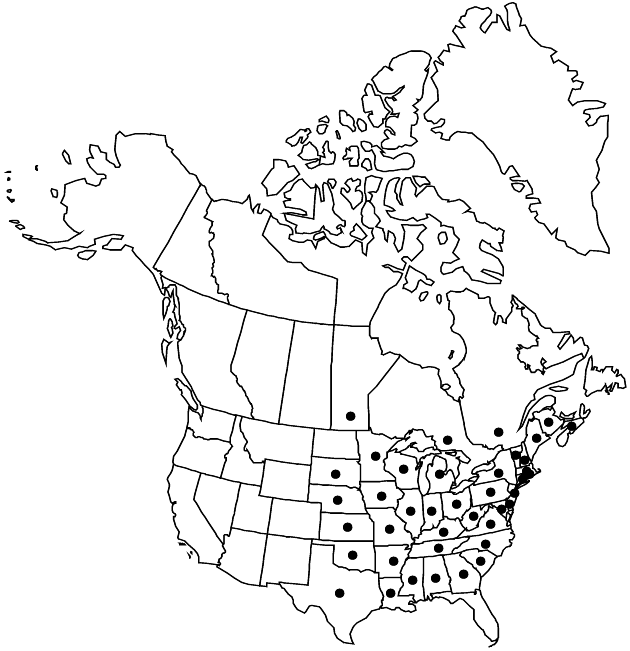Difference between revisions of "Antennaria parlinii"
Gard. & Forest 10: 284. 1897.
FNA>Volume Importer |
FNA>Volume Importer |
||
| Line 22: | Line 22: | ||
|distribution=e North America. | |distribution=e North America. | ||
|discussion=<p>Subspecies 2 (2 in the flora).</p><!-- | |discussion=<p>Subspecies 2 (2 in the flora).</p><!-- | ||
| − | --><p>The <i>Antennaria parlinii</i> complex consists of two fairly distinct subspecies that differ in induments of basal leaves (tomentose in < | + | --><p>The <i>Antennaria parlinii</i> complex consists of two fairly distinct subspecies that differ in induments of basal leaves (tomentose in <i></i>subsp.<i> fallax</i>; glabrous in <i></i>subsp.<i> parlinii</i>) and other characters (R. J. Bayer and G. L. Stebbins 1982). <i>Antennaria parlinii</i> is the most common eastern North American species (Bayer and Stebbins 1982, 1983). This complex of polyploid sexual and apomictic populations is the result of multiple hybridizations among sexual diploid species including <i>A. plantaginifolia</i>, <i>A. racemosa</i>, and <i>A. solitaria</i> (Bayer 1985b; Bayer and D. J. Crawford 1986). A. Cronquist (1945; H. A. Gleason and Cronquist 1991) included <i>A. parlinii</i> within his circumscription of <i>A. plantaginifolia</i>. By not including the hybrid polyploiid within the circumscription of a single one of its sexual progenitors, the circumscription here better portrays the evolutionary relationships between <i>A. parlinii</i> and its sexual progenitors.</p> |
|tables= | |tables= | ||
|references= | |references= | ||
| Line 45: | Line 45: | ||
-->{{#Taxon: | -->{{#Taxon: | ||
name=Antennaria parlinii | name=Antennaria parlinii | ||
| − | |||
|authority=Fernald | |authority=Fernald | ||
|rank=species | |rank=species | ||
| Line 57: | Line 56: | ||
|publication year=1897 | |publication year=1897 | ||
|special status= | |special status= | ||
| − | |source xml=https://jpend@bitbucket.org/aafc-mbb/fna-data-curation.git/src/ | + | |source xml=https://jpend@bitbucket.org/aafc-mbb/fna-data-curation.git/src/eaa6e58056e40c9ef614d8f47aea294977a1a5e9/coarse_grained_fna_xml/V19-20-21/V19_643.xml |
|tribe=Asteraceae tribe Gnaphalieae | |tribe=Asteraceae tribe Gnaphalieae | ||
|genus=Antennaria | |genus=Antennaria | ||
Revision as of 20:20, 16 December 2019
Dioecious or gynoecious (staminate plants in equal frequencies as pistillates or none in populations, respectively). Plants 12–35(–45) cm. Stolons 3.5–11(–14) cm (mostly decumbent when young). Basal leaves 3–5-nerved, obovate-spatulate, obovate, rhombic-obovate, or suborbiculate, 30–95 × 12–45 mm, tips mucronate, faces gray-pubescent to floccose-glabrescent. Cauline leaves oblong-lanceolate, 3.5–45 mm, distalmost flagged. Heads 4–12(–15) in tight corymbiform arrays. Involucres: staminate 6–9 mm; pistillate (7–)8–13 mm. Phyllaries distally white. Corollas: staminate 3.5–5 mm; pistillate 4–7 mm. Cypselae 1–2 mm, minutely papillate; pappi: staminate 4–5 mm; pistillate 5–8 mm. 2n = 56, 84, 70, 112.
Distribution

e North America.
Discussion
Subspecies 2 (2 in the flora).
The Antennaria parlinii complex consists of two fairly distinct subspecies that differ in induments of basal leaves (tomentose in subsp. fallax; glabrous in subsp. parlinii) and other characters (R. J. Bayer and G. L. Stebbins 1982). Antennaria parlinii is the most common eastern North American species (Bayer and Stebbins 1982, 1983). This complex of polyploid sexual and apomictic populations is the result of multiple hybridizations among sexual diploid species including A. plantaginifolia, A. racemosa, and A. solitaria (Bayer 1985b; Bayer and D. J. Crawford 1986). A. Cronquist (1945; H. A. Gleason and Cronquist 1991) included A. parlinii within his circumscription of A. plantaginifolia. By not including the hybrid polyploiid within the circumscription of a single one of its sexual progenitors, the circumscription here better portrays the evolutionary relationships between A. parlinii and its sexual progenitors.
Selected References
None.
Key
| 1 | Stems usually glandless; basal leaves adaxially tomentose | Antennaria parlinii subsp. fallax |
| 1 | Stems usually with purple glandular hairs (at least near summits of young flowering stems); basal leaves adaxially green-glabrous | Antennaria parlinii subsp. parlinii |